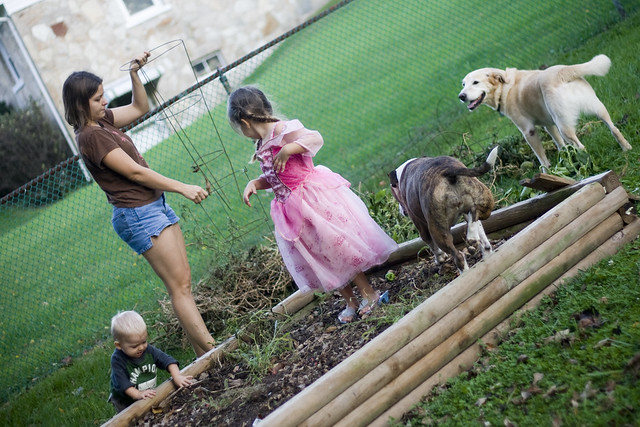On our list of goals for this year we have small livestock. Our goal is to replace our milk supply with dairy goats, and perhaps sell some goat milk products at a farmers market. We also would like a few meat goats to breed for meat in the fall, as well as the possibility to trade or barter the offspring.
Milking goats has been a hot-button issue for us though. We stay at home most days, but with three kids, one of them being 4 months old, getting up in time every day to milk a goat might be out of our grasp right now. We decided to work on getting the pasture ready for them, and then committing to the purpose our goats will serve. At the very least we will have some weed control in the pasture and can also use the goats elsewhere on the property to clear brush.
We have been eyeing up the land right now to figure out where to put the pasture. There is a section at the bottom of the property that gets pretty mucky when it rains. We want to see what we can do to fix the issue, but the probability of that being usable land is low in my mind. The thought right now is to leave that area to grow up as cover for the deer to permit them to come into the property from the neighboring cornfield.
Our county has a great GIS tool that we used before purchasing the property and it has come in handy again for planning the pasture. The area in red is the area we would like to fence as it has been unused. A farmer used to mow down the area 2x a year for his cattle, but we have not yet renewed the agreement.
This two acres will allow us to have roughly 20 goats, although I don't think we want to have quite so many. We can also eventually split the pasture into two sections to either rotate grazing or section off sick goats or bucks. It would also be useful during weaning.
Aside from measuring area, the GIS tool also allowed us to measure distance. This is helpful for budgeting what a fence would cost us.
The fence is roughly 1200 feet in length (not including a fence to split the pasture into two). A quick division by 16 gives us the number of posts we need - 75. We originally looked at t-posts to help with cost, but 3.5 inch wood posts cost only $1 more per post.
The next thing we need to decide is what type of fencing to use. I'd personally like to use high-tensile electric fencing with a solar charger. Reading online I see both ends of the spectrum as to its usefulness with goats. Some people say their goats won't go within 10 feet of it, while others say their goats walk right through it if they see better grazing elsewhere. I'd prefer not to aggravate my neighbors, so we are considering putting in 48" goat fence instead with an electric runner at the top. This increases the cost drastically as it is about $350 per 330' of goat fence.
Another challenge is water. There is a creek at the bottom and side of the property, but to get the goats there would be intrusive to the neighbors. Some options are hauling water daily, getting a solar pump, or burying pipes from the house.
Lastly, and something we need to figure out quickly, is a natural gas pipeline somewhere under the property. It is empty and has been since the 1960's. I have no idea the depth, but I'd find out quickly when an auger find it for us.
















